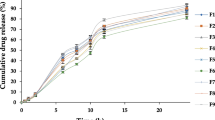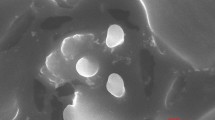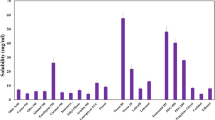Abstract
Since ancient times, medicinal plants are widely accepted to promote the health and wellness of animals and mankind. The medicinal plant-based therapies have limitations of delayed onset of action, inconsistent absorption, low bioavailability, oxidation, and poor solubility. The encapsulation studies suggested improved efficacy. Therefore, the present study attempts to evaluate the efficacy of Curcuma longa extracts encapsulated in Ethosome on wound healing model compared to crude extract. The Curcuma longa extract swere prepared by cold percolation method and total curcuminoid content was determined by Reverse phase-HPLC. Three Ethosomal suspensions (ETS1, ETS2, and ETS3) were prepared and characterized for particle distribution, morphology, and absorption spectrum by Zetasizer, Scanning Electron Microscopy, and FTIR respectively. The Ethosomal suspension with the highest entrapment efficiency was applied topically at a varying concentrations (0.25, 0.5, and 1 g/cm2) on the surgically created wounds in rats. The efficacy of wound healing was evaluated by clinical observation, macroscopic evaluation of granulation tissue, colour digital image processing, and histology. The methanolic extract of Curcuma longa showed better antibacterial potential than ethanolic and aqueous. The total Curcuminoid content in the Curcuma longa rhizome was 4.03%. The size, PDI, zeta potential, and viscosity of Ethosomal suspension ranged from 34.8 to 371 nm, 0.236–1.178, 15.6-36.8mV, and 0.8460–0.8510, respectively. The ETS3 was found the most optimum combination with the highest entrapment efficiency and the topical application at a dose rate of 0.5 g/cm2 and 1.0 g/cm2 resulted in comparable wound contracture, pain score, histopathological score as compared to control groups.It was concluded that the Curcuma longa encapsulation in Ethosome resulted in improved wound appearance, granulation tissue score, and appearance with a shortened period of wound resolution at the cellular level as compared to crude extract.
Graphical abstract








Similar content being viewed by others
Data availability
The dataset generated during the study is provided as 34 and also available with corresponding author which will be made available on request.
References
Ajige L, Sunday T, Elkanah F et al (2017) Comparative study of antibacterial effects of Curcuma longa Linn. and Zingiber officinale Rosc. Rhizomes. Microbiol Res J Int 18:1–8. https://doi.org/10.9734/mrji/2017/31551
Akbik D, Ghadiri M, Chrzanowski W, Rohanizadeh R (2014) Curcumin as a wound healing agent. Life Sci 116:1–7
Alemi A, Zavar Reza J, Haghiralsadat F et al (2018) Paclitaxel and curcumin coadministration in novel cationic PEGylated niosomal formulations exhibit enhanced synergistic antitumor efficacy. J Nanobiotechnol 16:1–20. https://doi.org/10.1186/s12951-018-0351-4
Antony B, Benny M, Rao SB (2005) Enhancing the absorption of curcuminoids. Spice India 23:26
Asai A, Miyazawa T (2000) Occurrence of orally administered curcuminoid as glucuronide and glucuronide/sulfate conjugates in rat plasma. Life Sci 67:2785–2793. https://doi.org/10.1016/S0024-3205(00)00868-7
Ashraf K, Mujeeb M, Ahmad A et al (2015) Determination of Curcuminoids in Curcuma longa Linn. by UPLC/Q-TOF–MS: An Application in Turmeric Cultivation. J Chromatogr Sci 53:1346–1352. https://doi.org/10.1093/chromsci/bmv023
Athira GK, Jyothi AN (2014) Preparation and characterization of curcumin loaded cassava starch nanoparticles with improved cellular absorption. Int J Pharm Pharm Sci 6:171–176
Atkins E, Bodel P (1972) Physiology in medicine: fever. N Eng J Med 286:27–34
Atmakuri LR, Dathi S (2010) Current trends in herbal medicines. J Pharm Res 3:109–113
Bigbie RB, Schumacher J, Swaim SF et al (1991) Effects of amnion and live yeast cell derivative on second-intention healing in horses. Am J Vet Res 52:1376–1382
Bonté F, Noel-Hudson MS, Wepierre J, Meybeck A (1997) Protective effect of curcuminoids on epidermal skin cells under free oxygen radical stress. Planta Med 63:265–266. https://doi.org/10.1055/s-2006-957669
Borena B, Pawde A, Aithal H et al (2010) Evaluation of autologous bone marrow-derived nucleated cells for healing of full-thickness skin wounds in rabbits. Int Wound J 7:249–260. https://doi.org/10.1111/j.1742-481X.2010.00683.x
Celia C, Cilurzo F, Trapasso E et al (2012) Ethosomes® and transfersomes® containing linoleic acid: Physicochemical and technological features of topical drug delivery carriers for the potential treatment of melasma disorders. Biomed Microdevices 14:119–130. https://doi.org/10.1007/s10544-011-9590-y
Chaudhary H, Kohli K, Kumar V (2013) Nano-transfersomes as a novel carrier for transdermal delivery. Int J Pharm 454:367–380
Chauhan P, Keni K, Patel R (2017) Investigation of phytochemical screening and antimicrobial activity of Curcuma longa. Int J Adv Res Biol Sci 4:153–163
Chen J, Dai WT, He ZM, Gao L, Huang X, Gong JM, Xing HY, Chen WD (2013) Fabrication and Evaluation of Curcumin-loaded Nanoparticles Based on Solid Lipid as a New Type of Colloidal Drug Delivery System. Ind J Pharma Sci 75(2):178–184
Dayan N, Touitou E (2000) Carriers for skin delivery of trihexyphenidyl HCl: ethosomes vs. liposomes. Biomaterials 21:1879–1885
Fatima Grace X, Rahul Raj S, Reshma I et al (2014) Herbal ethosomes-A novel approach in herbal drug technology. Am J Ethnomed 1:226–230
Ghamsari SM, Acorda JA, Taguchi K et al (1996) Evaluation of wound healing of the teatwith and without low level laser therapy in dairy cattle by laser doppler flowmetry in comparison with histopathology, tensiometry and hydroxyproline analysis. Br Vet J 152:583–592
Gunjan J, Swarnlata S (2014) Topical delivery of Curcuma longa extract loaded nanosized ethosomes to combat facial wrinkles. J Pharm Drug Deliv Res 3 3:1000118
Hadgraft J (2004) Skin deep. Eur J Pharm Biopharm 58:291–299
Hadi S, Artanti AN, Rinanto Y, Wahyuni DSC (2018) Curcuminoid content of Curcuma longa L. and Curcuma xanthorrhiza rhizome based on drying method with NMR and HPLC-UVD. In: IOP Conference Series: Materials Science and Engineering. IOP Publishing, p 12058
Hashemi SA, Madani SA, Abediankenari S (2015) The review on properties of aloe vera in healing of cutaneous wounds. Biomed Res Int 2015. https://doi.org/10.1155/2015/714216
Holleran WM, Takagi Y, Uchida Y (2006) Epidermal sphingolipids: metabolism, function, and roles in skin disorders. FEBS Lett 580:5456–5466
Institute undefined C and LS (2016) Clinical & Laboratory Standards Institute: CLSI Guidelines. https://clsi.org/media/2663/m100ed29_sample.pdf
Jagetia GC, Rajanikant GK (2004) Role of curcumin, a naturally occurring phenolic compound of turmeric in accelerating the repair of excision wound, in mice whole-body exposed to various doses of γ-radiation. J Surg Res 120:127–138
Jayaprakasha GK, Jagan Mohan Rao L, Sakariah KK (2002) Improved HPLC method for the determination of curcumin, demethoxycurcumin, and bisdemethoxycurcumin. J Agric Food Chem 50:3668–3672
Jin-guang C, Wei LAI, Yu J (2013) Preparation of curcumin ethosomes. Afr J Pharm Pharmacol 7:2246–2251
Jurenka JS (2009) Anti-inflammatory properties of curcumin, a major constituent of Curcuma longa: a review of preclinical and clinical research. Altern Med Rev 4(2):141–153
Lopez-Pinto JM, Gonzalez-Rodriguez ML, Rabasco AM (2005) Effect of cholesterol and ethanol on dermal delivery from DPPC liposomes. Int J Pharm 298:1–12
Luna LG (1968) Methods for carbohydrates and mucoproteins. Man Histol Stain methods armed forces, 3rd ed. Blakiston Division, McGraw-Hill
Mailafiya MM, Abubakar K, Danmaigoro A et al (2019) Evaluation of in vitro release kinetics and mechanisms of curcumin-loaded cockle shell-derived calcium carbonate nanoparticles. Biomed Res Ther 6(12):3518–3540. https://doi.org/10.15419/bmrat.v6i12.580
Madhavi BB, Vennela KS, Masana P, Madipoju B (2013) Enhanced transdermal drug penetration of curcumin via ethosomes. Malaysian J Pharm Sci 11:49
Manca ML, Zaru M, Manconi M et al (2013) Glycerosomes: a new tool for effective dermal and transdermal drug delivery. Int J Pharm 455:66–74
Manosroi A, Jantrawut P, Khositsuntiwong N et al (2009) Novel elastic nanovesicles for cosmeceutical and pharmaceutical applications. Chiang Mai J Sci 36:168–178
Marchal-Heussler L, Maincent P, Hoffman M et al (1990) Antiglaucomatous activity of betaxolol chlorhydrate sorbed onto different isobutylcyanoacrylate nanoparticle preparations. Int J Pharm 58:115–122. https://doi.org/10.1016/0378-5173(90)90248-3
Masson P (1929) Some histological methods: trichrome staining and their preliminary technique. J Tech Methods 12:75–90
Mathew DD, Sharma AK, Kumar N et al (2019) Healing potency of bone marrow derived mesenchymal stem cells from rat and dogs for wound healing in a rat model. Trends Biomater Artif Organs 33(2):30–46
Mohanty C, Acharya S, Mohanty AK et al (2010) Curcumin-encapsulated MePEG/PCL diblock copolymeric micelles: a novel controlled delivery vehicle for cancer therapy. Nanomedicine 5:433–449
Mukherjee PK, Harwansh RK, Bhattacharyya S (2015) Bioavailability of herbal products: approach toward improved pharmacokinetics. Evidence-Based Validation of Herbal Medicine. Elsevier, pp 217–245
National Committee for Clinical Laboratory Standards [WorldCat Identities]. http://worldcat.org/identities/lccn-n82041728/. Accessed 8 Mar 2021
Natsheh H, Touitou E (2020) Phospholipid Vesicles for Dermal/Transdermal and Nasal Administration of Active Molecules: The Effect of Surfactants and Alcohols on the Fluidity of Their Lipid Bilayers and Penetration Enhancement Properties. Molecules 25:2959. https://doi.org/10.3390/MOLECULES25132959
Neagoş D, Mitran V, Chiracu G et al (2006) Skin wound healing in a free floating fibroblast populated collagen lattice model. Rom J Biophys 16:157–168
Orsted L, Heather KD, Louise LF (2004) Principles of wound healing. Wound Care Canada 9:4–12. https://doi.org/10.1142/9789812791535_0028
Partoazar A, Kianvash N, Darvishi MH et al (2016) Ethosomal curcumin promoted wound healing and reduced bacterial flora in second degree burn in rat. Drug Res (Stuttg) 66:660–665
Pathan IB, Jaware BP, Shelke S, Ambekar W (2018) Curcumin loaded ethosomes for transdermal application: Formulation, optimization, in-vitro and in-vivo study. J Drug Deliv Sci Technol 44:49–57
Patwardhan B, Warude D, Pushpangadan P, Bhatt N (2005) Ayurveda and traditional Chinese medicine: A comparative overview. Evidence-based Complement. Altern Med 2:465–473
Petrie A, Watson P (2006) Additional techniques. Stat Vet Anim Sci 191–211
Prabaningdyah NK, Riyanto S, Rohman A (2018) Application of FTIR spectroscopy and multivariate calibration for analysis of curcuminoid in syrup formulation. J Appl Pharm Sci 8:172–179. https://doi.org/10.7324/JAPS.2018.8324
Rakesh R, Anoop KR (2012) Formulation and optimization of nano-sized ethosomes for enhanced transdermal delivery of cromolyn sodium. J Pharm Bioallied Sci 4:333
Ramadon D, Goldie AW, Anwar E (2017) Novel transdermal ethosomal gel containing green tea (Camellia sinensis L. Kuntze) leaves extract: formulation and in vitro penetration study. J Young Pharm 9:336
Reinke JM, Sorg H (2012) Wound repair and regeneration. Eur Surg Res 49:35–43
Samnani A, Shahwal V, Bhowmick M et al (2012) Design and evaluation of ultradeformable soft elastic nano vesicle ethosomes for dermal delivery. Int J Biomed Adv Res 3:111–117
Schallberger SP, Stanley BJ, Hauptman JG, Steficek BA (2008) Effect of porcine small intestinal submucosa on acute full-thickness wounds in dogs. Vet Surg 37:515–524
Schieffer GW (2002) Pressurized liquid extraction of curcuminoids and curcuminoid degradation products from turmeric (Curcuma longa) with subsequent HPLC assays. J Liq Chromatogr Relat Technol 25:3033–3044
Seema A (2014) Recent development of herbal formulation—a novel drug delivery system. Int Ayurvedic Med J 2:952–958
Sidhu GS, Singh AK, Thaloor D et al (1998) Enhancement of wound healing by curcumin in animals. Wound Repair Regen 6:167–177. https://doi.org/10.1046/j.1524-475X.1998.60211
Sinico C, Fadda AM (2009) Vesicular carriers for dermal drug delivery. Expert Opin Drug Deliv 6:813–825
Snedecor GW, Cochran WG (1989) Statistical methods, 8thEdn. Ames Iowa State Univ Press Iowa 54:71–82
Srivastava N, Singh K, Amrit K (2015) Formulation and evaluation of seabuckthorn leaf extract loaded ethosomal gel. Asian J Pharm Clin Res 8:316–320
Sujatha V, Vishnuvaravidyadhar T, Parvathi M, Reddy S (2021) A review on transdermal drug delivery system by ethosomes. Pharma News
Taverna D, Pollins AC, Sindona G et al (2015) Imaging mass spectrometry for assessing cutaneous wound healing: analysis of pressure ulcers. J Proteome Res 14:986–996
Tayyem RF, Heath DD, Al-Delaimy WK, Rock CL (2006) Curcumin content of turmeric and curry powders. Nutr Cancer 55:126–131
Thakur L, Ghodasra U, Patel N, Dabhi M (2011) Novel approaches for stability improvement in natural medicines. Pharmacogn Rev 5:48
Touitou E(1998) Composition for applying active substances to or through the skin
Touitou E, Dayan N, Bergelson L et al (2000) Ethosomes—novel vesicular carriers for enhanced delivery: characterization and skin penetration properties. J Control Release 65:403–418
Acknowledgements
Authors thankfully acknowledge Dr. Karuna Shanker, Senior Scientist, CIMAP, Lucknow for providing raw the Curcuma longa rhizome and analysis of crucuminoid contents. The author are also thankful to Director, ICAR-IVRI, Izatnagar for providing necessary infrastructure facility.
Funding
The present work was conducted under master degree programme at Division of Medicine, ICAR-IVRI, Izatnagar with no seperate funding by any organisation.
Author information
Authors and Affiliations
Contributions
Authors (Sumit Kumar, Akhilesh Kumar, Naveen Kumar, Praveen Singh, Thakur Uttam Singh, Bhoj Raj Singh, Piyush Kumar Gupta, and Vijay Kumar Thakur) contibuted to cenceptualization and design of study. The experimentation and data collection was performed by Sumit Kumar, Akhilesh Kumar, Naveen Kumar and Praveen Singh. All the authors contributed subtantially in data analysis. The first draft of manuscript writted by Sumit Kumar and Akhilesh Kumar and all the authors mentioned in manuscript contributed in the revision of manuscipt to present form. All authors read and approved the final manuscript.
Corresponding author
Ethics declarations
Conflict of interest
All the authors declare no conflict of interest.
Ethics approval
The animal experimentation protocols involved in this study was approved by the Institute Animal Ethics Committee (IAEC), ICAR-Indian Veterinary Research Institute, Izatnagar vide No.F.26 − 1/2018-19/J.D-R dated 05.08.2019.
Consent to participate
Not applicable.
Consent for publication
Not applicable.
Additional information
Publisher’s note
Springer Nature remains neutral with regard to jurisdictional claims in published maps and institutional affiliations.
Supplementary Information
Below is the link to the electronic supplementary material.
ESM 1
(DOCX 911 KB)
Rights and permissions
About this article
Cite this article
Kumar, S., Kumar, A., Kumar, N. et al. In vivo therapeutic efficacy of Curcuma longa extract loaded ethosomes on wound healing. Vet Res Commun 46, 1033–1049 (2022). https://doi.org/10.1007/s11259-022-09952-1
Received:
Accepted:
Published:
Issue Date:
DOI: https://doi.org/10.1007/s11259-022-09952-1




